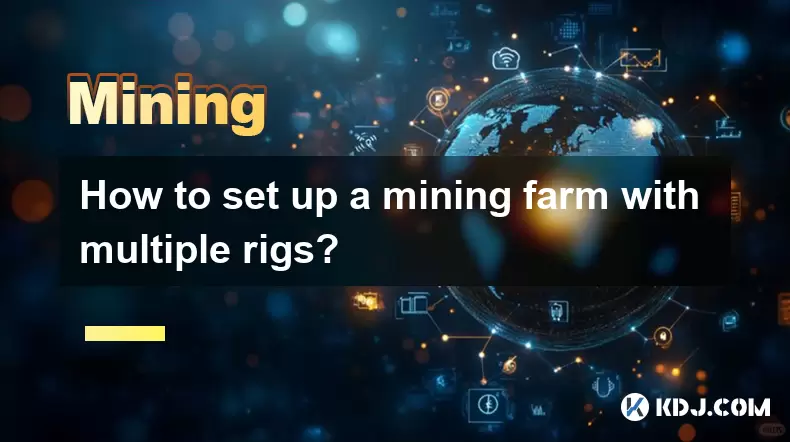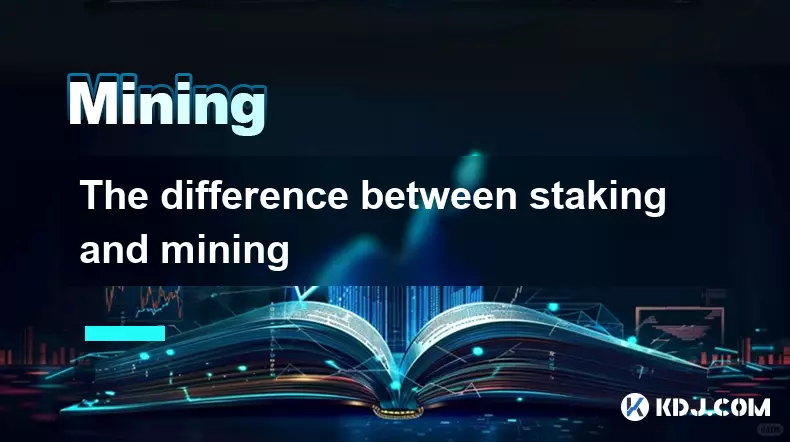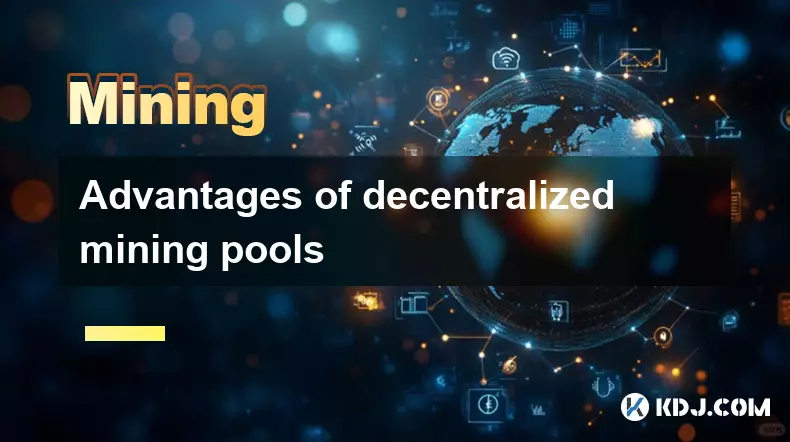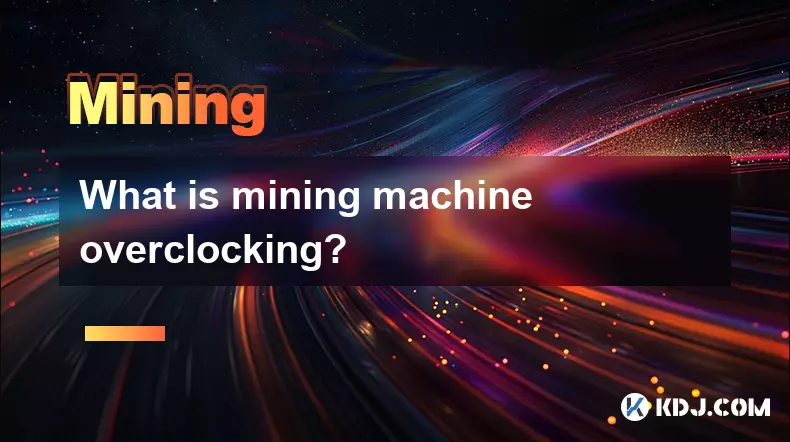-
 bitcoin
bitcoin $112195.049338 USD
2.42% -
 ethereum
ethereum $4124.915858 USD
2.81% -
 tether
tether $1.000570 USD
0.02% -
 xrp
xrp $2.861568 USD
2.25% -
 bnb
bnb $1000.346670 USD
3.04% -
 solana
solana $209.070819 USD
3.38% -
 usd-coin
usd-coin $0.999870 USD
0.02% -
 dogecoin
dogecoin $0.235379 USD
2.65% -
 tron
tron $0.335681 USD
-0.20% -
 cardano
cardano $0.803501 USD
3.38% -
 hyperliquid
hyperliquid $47.120881 USD
3.56% -
 chainlink
chainlink $21.501300 USD
3.44% -
 ethena-usde
ethena-usde $1.000571 USD
0.02% -
 avalanche
avalanche $29.793378 USD
3.62% -
 stellar
stellar $0.366964 USD
2.42%
How to set up a mining farm with multiple rigs?
A multi-rig mining farm boosts crypto mining power by combining specialized hardware like GPUs or ASICs, managed via centralized software such as HiveOS for optimal performance and monitoring.
Aug 07, 2025 at 12:38 am

Understanding the Basics of a Multi-Rig Mining Farm
Setting up a mining farm with multiple rigs begins with understanding the core components involved in cryptocurrency mining. A mining rig is essentially a computer system designed specifically to solve complex cryptographic equations in order to validate transactions on a blockchain. When multiple rigs are combined into a single operation, it becomes a mining farm, significantly increasing hashing power and potential rewards. The key components include graphics processing units (GPUs) or application-specific integrated circuits (ASICs), depending on the cryptocurrency being mined. For example, Ethereum historically favored GPU mining, while Bitcoin relies heavily on ASICs.
Before acquiring hardware, it’s essential to decide which cryptocurrency to mine, as this determines the type of hardware needed. Power supply units (PSUs) must be sufficient to handle the load of multiple GPUs or ASICs. Each rig typically requires a motherboard that supports multiple PCIe slots, a compatible CPU, sufficient RAM, and a reliable storage drive for the operating system. Networking components such as routers and Ethernet cables ensure stable internet connectivity across all rigs.
Selecting and Assembling Individual Mining Rigs
Each rig in the farm must be assembled with care to ensure stability and efficiency. Start by choosing a mining frame or open-air case that allows for optimal airflow and easy access to components. Install the motherboard securely, ensuring no contact with conductive surfaces. Attach the CPU and RAM, then connect the PSU—a high-efficiency unit (80 Plus Gold or higher) is recommended to minimize energy waste.
Next, install the GPUs into the PCIe slots. Use PCIe riser cables to connect each GPU to the motherboard, ensuring they are properly seated and secured. Connect the necessary PCIe power cables from the PSU directly to each GPU. It’s critical to use high-quality risers and cables to prevent power delivery issues. After all components are in place, double-check all connections and secure loose cables to avoid interference.
Choosing and Installing Mining Software
Once the hardware is assembled, the next step is configuring the software. Begin by installing a lightweight operating system such as HiveOS, RaveOS, or SimpleMiner, all of which are designed specifically for mining farms. These OS options provide centralized control, remote monitoring, and automatic updates. HiveOS, for instance, allows you to manage all rigs from a single dashboard via a web browser.
After flashing the OS onto a USB drive and booting each rig from it, configure network settings to ensure each rig obtains a unique IP address on the local network. Register each rig with your chosen mining OS dashboard using its unique identifier. Then, set up mining pools—servers that combine the computational power of multiple miners to increase the chances of earning block rewards. Popular pools include Ethermine, F2Pool, and Slush Pool, depending on the coin.
In the OS dashboard, specify the cryptocurrency, wallet address, and pool server details. Most systems allow you to apply these settings across multiple rigs simultaneously, streamlining configuration.
Power and Cooling Infrastructure Setup
A multi-rig mining farm consumes substantial electricity and generates significant heat. Proper power distribution is critical. Use industrial-grade power distribution units (PDUs) to supply electricity to multiple rigs safely. Avoid overloading household circuits—each circuit should not exceed 80% of its rated capacity. For example, a 15-amp circuit should not draw more than 12 amps continuously.
Cooling is equally important. High temperatures reduce efficiency and shorten hardware lifespan. Install high-CFM exhaust fans at the back of the mining area and intake fans at the front to create positive airflow. Maintain ambient temperatures below 28°C (82°F). Consider using air conditioning units or evaporative coolers in hot climates. Position rigs with space between them to prevent heat buildup. Monitor temperatures through the mining OS dashboard and set up alerts for overheating.
Network Configuration and Remote Management
Reliable network connectivity ensures uninterrupted mining operations. Use wired Ethernet connections instead of Wi-Fi for stability. Assign static IP addresses or use DHCP reservations to ensure each rig maintains a consistent network identity. Set up a dedicated router or VLAN for the mining farm to isolate traffic and improve security.
Remote management tools are essential when operating multiple rigs. Through HiveOS or RaveOS dashboards, you can monitor hashrates, temperatures, power consumption, and uptime in real time. Reboot unresponsive rigs remotely, update mining software, and adjust fan speeds or GPU core clocks to optimize performance. Enable SSH access for advanced troubleshooting. Regularly check logs for errors such as dropped shares or hardware failures.
Monitoring Performance and Troubleshooting Issues
Continuous monitoring helps maintain peak efficiency. Watch for hashrate fluctuations, which may indicate unstable overclocking or failing hardware. Use the dashboard to compare expected vs. actual hashrates based on your GPU models. Investigate rigs reporting zero hashrate immediately—common causes include disconnected GPUs, faulty risers, or driver issues.
Temperature spikes require prompt action. If a GPU exceeds 80°C, adjust fan curves or improve airflow. Persistent high temperatures may require undervolting—reducing voltage to lower heat output without sacrificing performance. Check power draw using a watt meter to verify efficiency and detect PSU problems.
Network disconnections can halt mining. Ensure Ethernet cables are securely plugged and switches are functioning. Reboot network equipment if multiple rigs go offline simultaneously. Keep spare components like risers, PSUs, and GPUs on hand to replace failed parts quickly.
Frequently Asked Questions
Can I mix different GPU models in the same mining farm?Yes, different GPU models can operate in the same farm, but they must be managed individually in the mining software. Each GPU type may require separate overclocking profiles and power settings. Mixing models can complicate optimization but is feasible with proper configuration.
How do I protect my mining farm from power surges?Install surge protectors rated for high-power devices and consider a whole-house surge suppressor. Use uninterruptible power supplies (UPS) for critical rigs to prevent sudden shutdowns during outages. Avoid plugging mining equipment into standard power strips not designed for sustained high loads.
Is it necessary to use a separate wallet for each rig?No, all rigs can send mined coins to the same wallet address. The mining pool aggregates rewards based on contributed work, regardless of how many rigs are involved. Ensure the wallet address is correctly entered in the mining software configuration.
What should I do if a rig stops submitting shares?First, check the network connection and power supply. Reboot the rig remotely or manually. Verify the mining pool URL and wallet address are correct. Inspect the GPU and riser connections. If the issue persists, test the GPU in another rig to isolate the problem.
Disclaimer:info@kdj.com
The information provided is not trading advice. kdj.com does not assume any responsibility for any investments made based on the information provided in this article. Cryptocurrencies are highly volatile and it is highly recommended that you invest with caution after thorough research!
If you believe that the content used on this website infringes your copyright, please contact us immediately (info@kdj.com) and we will delete it promptly.
- Creator Economy Revolution: Video Streaming, AI Algorithms, and the Tokenization Tsunami
- 2025-09-29 10:25:16
- Bitcoin, Ethereum, and Q4 Predictions: What's the Buzz?
- 2025-09-29 10:25:16
- Token Unlocks, DeFi, and Tokenomics: Navigating the Crypto Landscape
- 2025-09-29 10:45:13
- Crypto Bull Wipeout? Dollar Strength Steals the Show!
- 2025-09-29 10:30:01
- AlphaTON, TON, and Meme Tokens: What's the Haps?
- 2025-09-29 10:45:13
- Kanye West, YZY, and Tickets: A Wild Ride in the Crypto and Concert World
- 2025-09-29 10:30:01
Related knowledge

The difference between staking and mining
Sep 24,2025 at 05:18am
Understanding Staking in the Cryptocurrency Ecosystem1. Staking involves holding funds in a cryptocurrency wallet to support the operations of a block...

How to participate in testnet mining?
Sep 22,2025 at 09:18am
Understanding Testnet Mining in the Crypto Ecosystem1. Testnet mining is a method used by blockchain developers to simulate real-world conditions on a...

How to dispose of abandoned mining machines?
Sep 19,2025 at 08:19pm
Assessing the Condition of Abandoned Mining Rigs1. Begin by inspecting each mining machine for visible damage, corrosion, or missing components. Machi...

How to identify high-quality mining pools?
Sep 21,2025 at 03:19pm
Reputation and Track Record1. A mining pool’s reputation is built over time through consistent performance and transparency. Pools that have operated ...

Advantages of decentralized mining pools
Sep 20,2025 at 04:36pm
Enhanced Security and Resistance to Censorship1. Decentralized mining pools operate on blockchain-based smart contracts, eliminating the need for a ce...

What is mining machine overclocking?
Sep 21,2025 at 07:19pm
Understanding Mining Machine Overclocking1. Mining machine overclocking refers to the process of increasing the operating frequency of a cryptocurrenc...

The difference between staking and mining
Sep 24,2025 at 05:18am
Understanding Staking in the Cryptocurrency Ecosystem1. Staking involves holding funds in a cryptocurrency wallet to support the operations of a block...

How to participate in testnet mining?
Sep 22,2025 at 09:18am
Understanding Testnet Mining in the Crypto Ecosystem1. Testnet mining is a method used by blockchain developers to simulate real-world conditions on a...

How to dispose of abandoned mining machines?
Sep 19,2025 at 08:19pm
Assessing the Condition of Abandoned Mining Rigs1. Begin by inspecting each mining machine for visible damage, corrosion, or missing components. Machi...

How to identify high-quality mining pools?
Sep 21,2025 at 03:19pm
Reputation and Track Record1. A mining pool’s reputation is built over time through consistent performance and transparency. Pools that have operated ...

Advantages of decentralized mining pools
Sep 20,2025 at 04:36pm
Enhanced Security and Resistance to Censorship1. Decentralized mining pools operate on blockchain-based smart contracts, eliminating the need for a ce...

What is mining machine overclocking?
Sep 21,2025 at 07:19pm
Understanding Mining Machine Overclocking1. Mining machine overclocking refers to the process of increasing the operating frequency of a cryptocurrenc...
See all articles










































































